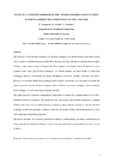Mostrar el registro sencillo del ítem
Study of a complete thermoelectric generator behavior including water-to-ambient heat dissipation on the cold side
| dc.creator | Aranguren Garacochea, Patricia | es_ES |
| dc.creator | Astrain Ulibarrena, David | es_ES |
| dc.creator | Martínez Echeverri, Álvaro | es_ES |
| dc.date.accessioned | 2016-04-11T14:13:18Z | |
| dc.date.available | 2016-04-11T14:13:18Z | |
| dc.date.issued | 2014 | |
| dc.identifier.issn | 0361-5235 (Print) | |
| dc.identifier.issn | 1543-186X (Electronic) | |
| dc.identifier.uri | https://hdl.handle.net/2454/20429 | |
| dc.description | The final publication is available at Springer via http://dx.doi.org/10.1007/s11664-014-3057-x | en |
| dc.description.abstract | The reduction of the thermal resistances of the heat exchangers of a thermoelectric generation system (TEG), leads to a significant increase in the TEG efficiency. For the cold side of a thermoelectric module (TEM), a wide range of heat exchangers has been studied, form simple finned dissipators to more complex water (water-glycol) heat exchangers. As Nusselt numbers are much higher in water heat exchangers than in conventional air finned dissipators, convective thermal resistances are better. However, to conclude which heat exchanger leads to higher efficiencies, it is necessary to include the whole system involved in the heat dissipation, that is, TEM-to-water heat exchanger, water-to-ambient heat exchanger, as well as the required pumps and fans. This paper presents a dynamic computational model able to simulate the complete behavior of a TEG, including both heat exchangers. The model uses the heat transfer and hydraulic equations to compute TEM-to-water and water-to-ambient thermal resistances, along with the resistance of the hot side heat exchanger at different operating conditions. Likewise, the model includes all the thermoelectric effect with temperature-dependent properties. The model calculates the net power generation at different configurations, providing a methodology to design and optimize the heat exchange in order to maximize the net power generation for a whole variety of TEGs. | en |
| dc.description.sponsorship | The authors are indebted to the Spanish Ministry of Economy and Competitiveness and the European Regional Development Fund for economic support of this work, included in the DPI2011-24287 Research Project. | en |
| dc.format.mimetype | application/pdf | en |
| dc.language.iso | eng | en |
| dc.publisher | Springer US | en |
| dc.publisher | TMS | en |
| dc.publisher | IEEE | en |
| dc.relation.ispartof | Journal of Electronic Materials, volume 43, issue 6, pp. 2320-2330 | en |
| dc.rights | © 2014 TMS | en |
| dc.subject | Thermoelectric generation | en |
| dc.subject | Heat exchanger | en |
| dc.subject | Heat dissipation | en |
| dc.subject | Computational model | en |
| dc.title | Study of a complete thermoelectric generator behavior including water-to-ambient heat dissipation on the cold side | en |
| dc.type | Artículo / Artikulua | es |
| dc.type | info:eu-repo/semantics/article | en |
| dc.contributor.department | Ingeniería Mecánica, Energética y de Materiales | es_ES |
| dc.contributor.department | Mekanika, Energetika eta Materialen Ingeniaritza | eu |
| dc.rights.accessRights | Acceso abierto / Sarbide irekia | es |
| dc.rights.accessRights | info:eu-repo/semantics/openAccess | en |
| dc.identifier.doi | 10.1007/s11664-014-3057-x | |
| dc.relation.projectID | info:eu-repo/grantAgreement/MICINN//DPI2011-24287/ES/ | en |
| dc.relation.publisherversion | https://doi.org/10.1007/s11664-014-3057-x | |
| dc.type.version | Versión aceptada / Onetsi den bertsioa | es |
| dc.type.version | info:eu-repo/semantics/acceptedVersion | en |


